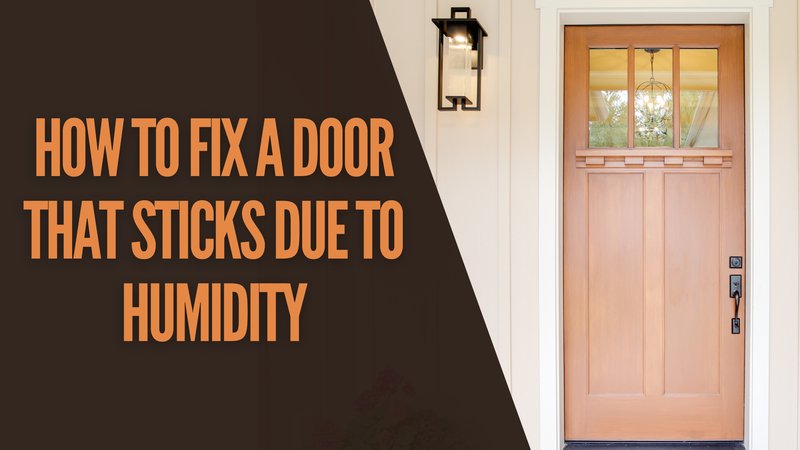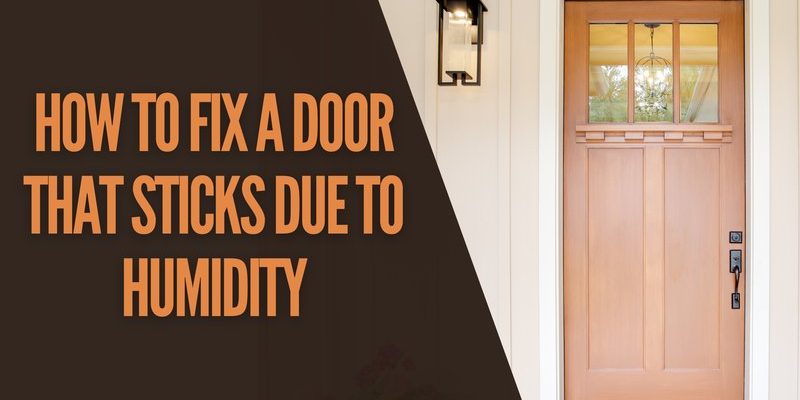
So, why does this happen, especially in places with high humidity? Well, when moisture interacts with the metal parts of the latch, it can lead to rust or corrosion, making it tough for the latch to operate smoothly. Brands like Kwikset and Schlage aren’t immune to this problem. When a latch sticks, it can become a hassle not only for you but for anyone trying to come and go. Let’s dig into how you can keep those latches working effortlessly, even when the weather isn’t on your side.
Understanding How Humidity Affects Door Latches
Humidity, at its core, is simply the presence of water vapor in the air. In high humidity, the air is saturated, which can lead to condensation on surfaces. Door latches, usually made from metal, can absorb this moisture. This absorption can lead to a few key problems:
- Rust formation: Rust occurs when moisture combines with metal, leading to corrosion. This can cause the latch to stick or bind.
- Expansion of materials: Metal parts expand when they absorb moisture. This can create tight spots in the latch mechanism.
- Lubrication breakdown: Humidity can wash away lubricants, making the latch less effective.
You might be wondering, “How does this relate to everyday life?” Well, if you’ve ever struggled to open a door during a summer storm, you’ve felt the effects of humidity firsthand. Understanding these interactions is the first step toward prevention.
Common Signs of a Sticking Door Latch
Before we dive into solutions, let’s identify what a sticking door latch looks like. Recognizing the signs can save you time and frustration down the line. Here are a few indicators:
- Resistance when turning the knob: If the knob feels stiff or doesn’t turn easily, it’s a good sign that the latch is sticking.
- Noise: Unusual squeaking or grinding sounds may indicate that your latch is having trouble moving.
- Delayed action: If it takes a moment for the latch to engage or disengage, moisture might be creeping in.
These signs can be subtle at first, but ignoring them can lead to more significant problems, like needing to replace the entire latch. So, keep an eye out.
Routine Maintenance to Prevent Sticking
One of the best ways to prevent sticking is through regular maintenance. Just like you wouldn’t ignore the oil change in your car, your door latches need some TLC too. Here are some steps to keep them in good shape:
1. Clean the latch: Use a soft cloth to wipe down the latch and surrounding areas. This helps remove dust and debris.
2. Inspect for rust: Check for any signs of rust or corrosion. If you see any, it’s best to address it immediately.
3. Lubricate regularly: Use a silicone-based lubricant or graphite powder to keep the latch moving smoothly. Avoid using oil-based lubricants as they can attract dirt.
This routine might seem tedious, but it can save you from the headaches of a stuck door. Think of it as a quick 5-minute check that saves you from a stuck latch disaster later.
Choosing the Right Lubricant
Not all lubricants are created equal, especially when it comes to humidity. Here’s a breakdown of what works best:
- Silicone spray: Great for resisting moisture and doesn’t attract dirt.
- Graphite powder: Ideal for door locks and latches as it doesn’t attract grime.
- WD-40: Good for initial cleaning but should be followed up with silicone or graphite to prevent dirt buildup.
Using the right lubricant not only helps in preventing sticking but also extends the life of your latch. Honestly, it’s like providing a cozy blanket to your latch on a chilly day.
Installing a Humidity-Resistant Latch
If your area is prone to extreme humidity, it might be worth considering a latch designed to withstand moisture. Look for:
- Stainless steel latches: These are resistant to rust and corrosion.
- Plastic latches: While not as robust as metal, high-quality plastic options can handle moisture without rusting.
Switching to a more resilient latch might require some effort initially. Still, it can save you the hassle of constant maintenance and repairs in the long run.
Tips for Managing Indoor Humidity
Sometimes, the best way to handle a sticking door latch is to manage the humidity inside your home. Here are some strategies to consider:
– Use a dehumidifier: This can significantly reduce moisture in the air, making your home more comfortable and your latches less prone to sticking.
– Ventilate: Open windows during dry parts of the day and use exhaust fans in areas like the kitchen and bathroom to keep moisture levels down.
– Seal windows and doors: Ensuring that there are no leaks can help maintain indoor humidity levels.
By taking these steps, you can create an environment that’s not as friendly to unwanted moisture, leading to fewer issues with those pesky door latches.
Sticking door latches can be a real pain, especially when humidity is high. But with a bit of routine maintenance, the right lubrication, and humidity management, you can keep your latches functioning smoothly. Think of it as a small investment of your time that pays off in convenience and peace of mind.
Whether you’re dealing with a lock from Kwikset, Schlage, or any other brand, these tips can help ensure your door remains a welcoming entrance. Remember, a little attention goes a long way toward preventing frustration, and soon enough, you’ll be opening doors with ease, rain or shine!
